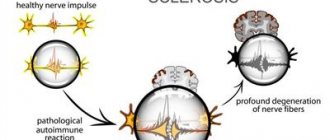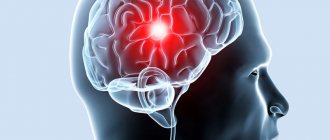Hippocampal sclerosis is a form of epilepsy that is characterized by severe symptoms. With pathology, there is loss of neurons and scarring in the deep parts of the temporal lobe. With sclerosis of the hippocampus, irreversible changes are observed, which negatively affects the patient’s standard of living.
Hippocampal sclerosis - what is it?
To take a closer look at this disease, we need to say a little about the disease that provokes it.
Temporal lobe epilepsy is a neurological disease that is accompanied by seizures. Its focus is in the temporal lobe of the brain. Seizures can occur with or without loss of consciousness. Mesial sclerosis acts as a complication and is accompanied by loss of neurons. Due to head injuries, various infections, seizures, tumors, the tissue of the hippocampus begins to atrophy, which leads to the formation of scars. There is a possibility that the course of the disease will be aggravated by additional seizures. It can be either right- or left-handed.
Based on structural changes, hippocampal sclerosis can be divided into two types:
- There are no volumetric changes in the temporal lobe of the brain.
- There is a process of increasing volume (aneurysm, progressive tumor, hemorrhage).
Find out about the symptoms and diagnosis of sclerosis here, and how to treat the disease, read the article.
Types and diagnosis of the disease
In accordance with the structural changes, temporal lobe epilepsy can have a volumetric process or be characterized by its absence. In the first case, patients are diagnosed with the development of tumor processes, aneurysms in blood vessels, hemorrhages, and congenital pathologies.
All pathological processes negatively affect the functioning of the limbic system.
To diagnose mesial temporal sclerosis, it is recommended to visit a neurologist. The doctor will examine the patient and collect anamnesis, which will allow him to make a preliminary diagnosis. To confirm it, it is recommended to use:
- Neuroradiological diagnostics;
- Angiography;
- Nuclear magnetic resonance imaging;
- Electroencephalography;
- Computed tomography.
Modern equipment is used to conduct research, which guarantees the accuracy of the results obtained.
For hippocampal sclerosis, a comprehensive diagnosis is recommended, which will allow an accurate diagnosis and effective treatment.
Main reasons
The main reasons include the following:
- Genetic factor. If parents or relatives had manifestations of temporal lobe epilepsy or sclerosis, then the likelihood of manifestation in the heirs is extremely high.
- Febrile seizures. Their influence contributes to various metabolic disorders. The cortex of the temporal lobe swells and the destruction of neurons begins, the tissue atrophies, the hippocampus decreases in volume.
- Mechanical injuries. Blows to the head, skull fractures, collisions, all this leads to irreversible damage and the development of hippocampal sclerosis.
- Bad habits. Alcoholism and nicotine addiction destroy neural connections and destroy brain cells.
- Childhood trauma. Incorrect development of the temporal lobe during the prenatal period or various birth injuries.
- Oxygen starvation of brain tissue. It can be caused by respiratory and metabolic disorders.
- Infections. Meningitis, encephalitis and other inflammations in the brain can lead to activation of mesial sclerosis.
- Poisoning. Intoxication of the body with harmful substances over a long period of time.
- Circulatory disorders. When blood circulation in the temporal lobe is impaired, ischemia and neuronal death begin, followed by atrophy and scarring.
You will find medications used for sclerosis here, you will find treatment with folk remedies by clicking on the link.
Preventive actions
In order to reduce the frequency of seizures, experts recommend regularly taking prescribed medications, as well as:
- Follow a rest and sleep schedule; you need to go to bed and wake up at the same time.
- Adhere to a diet that includes limiting the consumption of spicy, salty and fried foods, as well as liquids.
- Avoid consuming alcoholic beverages; alcohol-containing products lead to the development of many different diseases.
- Eliminate the consumption of tobacco products - tobacco and combustion products negatively affect all body systems.
- Avoid overheating or hypothermia of the body; to do this, you should avoid visiting baths and saunas, and sunbathing in the open sun.
- Eliminate consumption of tea and coffee.
Symptoms
Reference! Since this disease is caused by epilepsy, its symptoms can be very similar to its manifestations, or to those of Alzheimer's disease.
The signs of hippocampal sclerosis should be examined in more detail, but only a competent specialist can make an accurate diagnosis.
Symptoms include:
A person’s habits change, he behaves differently than usual.- Frequent dizziness.
- Headache, frequent pain of unknown pathogenesis.
- Insomnia or vice versa drowsiness.
- The appearance of panic attacks.
- Forgetfulness or complete amnesia.
- Spasms of various muscle groups.
- Various cramps.
- The person becomes anxious.
- Various cognitive disorders occur. In addition to memory problems, a person cannot concentrate on anything, and his train of thought is disrupted.
- Emotional and sexual behavior changes.
During the examination, the following changes can be diagnosed:
- Decreased white matter content in the parahippocampal gyrus.
- Depletion of the amygdala.
- Atrophy of part of the diencephalon nucleus.
- Reduction of the singular gyrus.
- Atrophy of the cerebral vault.
In the presence of left-sided mesial sclerosis, symptoms will be more severe than with right-sided mesial sclerosis and cause more serious damage to the parasympathetic system. Seizures disrupt the overall functioning of all parts of the brain and can even cause problems with the heart and other organs.
Read the article on how to deal with atherosclerosis; learn about the treatment of the disease here.
Symptoms of pathology
With hippocampal sclerosis, patients are diagnosed with partial epilepsy. This condition results in a variety of symptoms. Relatives and friends notice that a person’s behavior is changing. Mesial temporal sclerosis leads to muscle spasms. During the course of the pathology, patients are diagnosed with the occurrence of seizures.
Hippocampal sclerosis is accompanied by memory loss. When sick, patients complain of headaches and dizziness. Insomnia indicates pathology. With mesial sclerosis, an increase in anxiety and the occurrence of panic attacks are noted. The patient's cognitive abilities are impaired: memory, thinking, concentration.
When examining the patient, atrophic processes are observed in the anterior nucleus of the thalamus. Hippocampal sclerosis is characterized by atrophy of the cingulate gyrus. When the disease occurs, ipsilateral cerebral hypertrophy is diagnosed. In the brain, white matter decreases in volume.
With hippocampal sclerosis, contralateral cerebellar hemoatrophy appears. The cerebral convolutions decrease in volume. During the course of the disease, atrophic processes appear in the mastoid body and the ipsilateral fornix.
With mesial sclerosis, patients are diagnosed with seizures, which lead to disruption of brain function. Patients suddenly lose consciousness. They develop autonomic cardiac dysfunction. In left-sided hippocampal sclerosis, more severe parasympathetic dysfunction is observed.
Hippocampal sclerosis is characterized by pronounced symptoms, in the event of which the patient is advised to urgently seek help from a doctor to ensure a full diagnosis and prescribe effective treatment.
Development of hippocampal sclerosis
Reference! Approximately 60-70% of patients with temporal lobe epilepsy have some degree of developed sclerosis of the hippocampus.
The clinical signs of the disease are very diverse, but the main ones are febrile convulsions. They can occur even before the onset of epilepsy, and this is associated with various neural disorders.
In this disease, the hippocampus is destroyed unevenly, the dentate gyrus and several other areas are affected. Histology indicates neuronal death and gliosis. In adults, bilateral degenerative disorders in the brain begin.
Atherosclerosis can develop for various reasons, but the consequences of the disease depend on the pathogenesis, timely diagnosis and adherence to a certain lifestyle.
The essence of the pathological process
With the development of sclerosis, unaffected organs and soft tissues are replaced by connective tissue that has a dense structure. This mechanism can be provoked by factors such as the development of the inflammatory process, age, deterioration of the immune system and addictions. In this regard, taking into account the area of development of the pathological process, tuberous or atherosclerosis, cerebral vascular sclerosis, etc. are distinguished.
Measures to be taken for treatment
To stop attacks and alleviate the manifestations of temporal sclerosis, special antiepileptic drugs are usually prescribed. These are mainly anticonvulsant medications. The dosage and regimen should be selected by a specialist. You cannot self-medicate, because you must correlate the manifestation of attacks, their type, the properties of the prescribed medication and many other things.
If the symptoms of attacks disappear, this indicates that the disease is receding. If seizures do not make themselves felt for two years, the doctor reduces the dosage of medications. Complete discontinuation of medications is prescribed only after 5 years of complete absence of symptoms.
Note! The goal of conservative therapy is complete relief of the manifestations of the disease and, if possible, a complete recovery.
When drug therapy does not bring results, surgery is prescribed. There are several types of surgical interventions for this disease, but the most commonly used is temporal lobotomy.
During this manipulation, the doctor removes the pathologically altered part of the brain, after making sure that it is not responsible for the vital functions of the body. A favorable outcome after such an intervention is observed in 55–95% of patients.
Find out how to treat atherosclerosis - by clicking on the link, drugs to block the disease, as well as folk remedies (herbs) in the fight against the disease.
Diagnostic measures
Neurologists are involved in diagnosing this condition. It is this specialist who should be contacted if the clinical picture described above manifests itself. During the first visit, the attending physician will talk with the patient to obtain a medical history. During the dialogue, the doctor assesses the patient’s intellectual capabilities and determines behavioral traits. If emotional or intellectual abnormalities are detected, the patient is referred for examination to a psychiatrist.
Along with this, the medical specialist will undertake a number of manipulations to assess the patient’s reflexes:
- in the knee joint;
- in the carpal-radial joint;
- as well as the reflex function of the biceps muscles of the shoulders.
During the diagnosis, the patient undergoes the following studies:
- An electroencephalogram allows you to identify existing foci of pathological impulses in the brain.
- CT and MRI make it possible to take a layer-by-layer image of the brain and other structures of the skull.
- Angiography determines the presence of disturbances in the blood flow of the brain.
- ECHO is an encephalogram, which is important if the patients are newborns or young children.










